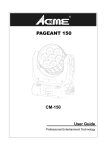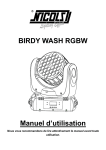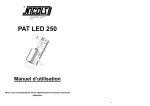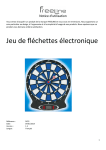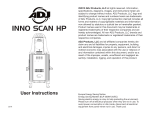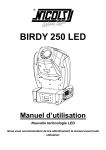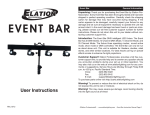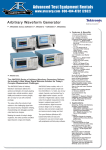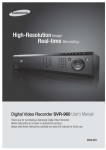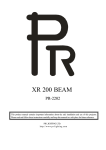Download BIRDY WASH 120 Manuel d`utilisation
Transcript
BIRDY WASH 120 Manuel d’utilisation Nouvelle technologie LED Nous vous recommandons de lire attentivement le manuel avant toute utilisation. TABLE DES MATIERES 1. Conseil de sécurité 2. Caractéristiques techniques 3. Réglage de l’appareil 3.1 Panneau de contrôle 3.2 Fonctions principales 3.3 Réglage de la position de départ 4. Utilisation de l’appareil 4.1 MASTER/SLAVE 4.2 Télécommandes 4.3 Contrôleur DMX 4.4 Configuration DMX 512 4.5 Branchement DMX 512 5. Dépannage de l’appareil 6. Nettoyage de l’appareil 1B 1. Conseils de sécurité Nous vous rappelons l’importance de la lecture de la notice d’utilisation et du respect des conseils de sécurité et d’utilisation afin d’éviter tout danger ou d’endommager l’appareil suite à une mauvaise manipulation. Conservez le présent manuel avec l'équipement pour référence ultérieure. En cas de vente de l'équipement à un autre utilisateur, il est important que le présent manuel soit joint à l'équipement afin que le nouvel utilisateur dispose des informations nécessaires à son utilisation et puisse prendre connaissance des mises en gardes relatives à la sécurité. Lors du déballage de l’appareil, assurez-vous que toutes les pièces sont présentes et que l’appareil n’a pas été endommagé pendant le transport. Assurez-vous que l’alimentation est compatible à la tension locale. Il est important que l’appareil soit relier à la prise de terre afin d’éviter tout choc électrique. L’appareil doit être utilisé dans une pièce bien ventilée et à au moins 50 cm des murs. L’appareil a été conçu pour une utilisation en INTERIEUR uniquement. Vérifiez que les ouïes de ventilation de l’appareil sont bien dégagées. Débranchez l’appareil du secteur avant le remplacement d’une pièce ou avant toute réparation ou entretien. Utilisez toujours des pièces de même type si vous deviez les remplacer. Par sécurité, assurez-vous qu’aucun produit inflammable ne se trouve à côté de l’appareil lors de l’utilisation. Utilisez des élingues de sécurité pour la fixation de l’appareil. Ne pas porter l’appareil par la tête mais toujours par la base. La température maximale pour une utilisation sans danger est de 40°. Ne jamais utiliser l’appareil si la température est supérieure à 40°. La surface de l’appareil peut atteindre 85°. Ne pas toucher l’appareil à mains nues pendant son fonctionnement. Eteindre l’appareil puis attendre 15 minutes pour que l’appareil refroidisse. Si vous rencontrez des problèmes à l’utilisation, éteignez immédiatement l’appareil. N’essayez pas de réparer l’appareil par vous même. L’appareil ne contient pas de pièces que puissiez remplacer par vous-mêmes. Les réparations effectuées par du personnel non qualifié peuvent engendrer des dommages. Il est important de contacter le revendeur pour toute réparation. L’appareil ne contient pas de pièces que puissiez remplacer par vous-mêmes. Ne pas toucher les fils pendant que l’appareil fonctionne afin d’éviter tout choc électrique. 2B L’appareil ne contient pas de pièces que puissiez remplacer par vous-mêmes. Afin d’éviter toute sorte de chocs électriques, ne jamais exposer l’appareil à la pluie ou à l’humidité. Ne pas ouvrir l’appareil dans les 5 minutes après son arrêt. Le boitier, les lentilles et le filtre UV doivent être remplacés s’ils sont endommagés Il est IMPERATIF de ne jamais regarder directement la source lumineuse sous risque de graves séquelles oculaires. ATTENTION aux émissions des LEDS qui pourraient blesser ou irriter l’œil. INSTALLATION DE L’APPAREIL Vous pouvez installer l’appareil au plafond ou sur une structure. Utilisez les emplacements de fixation de la lyre d’accroche. Nous vous recommandons de bien vouloir veiller à ce que l'appareil soit solidement fixé afin que l'appareil ne ressente aucune vibration pendant que celui-ci est en marche. Il ne doit pas glisser. Assurez-vous que la structure sur laquelle est fixé l'appareil est assez solide (pouvant soutenir 10 fois le poids de l’appareil). Nous vous recommandons également d‘ utiliser une élingue de sécurité, celle-ci doit pouvoir supporter 12 fois le poids de l’appareil. L’installation doit être faite par des professionnels. Assurez que votre installation soit hors de portée de toute personne et qu’elle ne gène en aucun cas le passage. 2. Caractéristiques techniques Lyre compacte, rapide et puissante à LED Canaux DMX : 9/12/14/16/28 Pan/Tilt: 630°/200°, vitesse ajustable Dimmer : 0-100% Strobe avec sur effet BPM et effets aléatoires Télécommandes en option : CA-8 / CA-9 RX Basse consommation Alimentation: 230 V/50Hz Fusible : T 6.3A Consommation : 150W LED : 10W, 4 couleurs (Rouge x 12, Vert x 12, Bleu x 12, Blanc12) Dimension: 304X267X168 mm Poids : 5.8 kg 3B 3. Réglage de l’appareil 3.1 Panneau de contrôle Affichage : Pour voir les différentes fonctions et les différents menus LED DMX On Entrée DMX activée MASTER On Mode Master activé SLAVE On Mode Slave activé SOUND Clignotement Mode musical activé Boutons MENU Pour sélectionner les fonctions DOWN Pour retourner dans les fonctions UP Pour avancer dans les fonctions ENTER Pour confirmer votre choix Télécommande uniquement : CA-8/CA-9RX et TX pour contrôler les appareils Entrée principale : Branchement au secteur Sortie principale: Pour brancher les appareils entre eux Entrée/Sortie DMX : Utiliser un câble XLR 3 ou 5 broches pour relier les appareils entre eux dans une chaîne DMX. 4B 3.2 Fonctions principales Pour sélectionner n'importe quelles fonctions de l'appareil, appuyez sur le bouton MENU jusqu'à ce que la fonction souhaitée s'affiche. Appuyez sur le bouton ENTER pour sélectionner la fonction. L'affichage clignote. Utilisez les boutons DOWN et UP pour changer le mode. Une fois que le mode souhaité a été sélectionné, appuyez sur le bouton ENTER pour enregistrer. Pour retourner aux fonctions principales sans avoir fait de changement, appuyez sur le bouton MENU de nouveau. Maintenez enfoncé le bouton MENU pendant 1 seconde ou attendez 1 minute pour sortir du mode menu. Les fonctions principales sont détaillées ci-dessous 5B 6B Adresse DMX Sélectionnez DMX Address. Appuyez sur le bouton ENTER pour confirmer. L’adresse en cours clignote. Utilisez les boutons UP et DOWN pour régler l’adresse de 1 à 512. Une fois l’adresse sélectionnée, appuyez sur le bouton ENTER pour enregistrer. Pour retourner aux fonctions sans avoir fait de modifications, appuyez sur le bouton MENU de nouveau. Appuyez et maintenez enfoncé le bouton MENU pendant 1 seconde ou attendez 1 minute pour sortir du mode MENU. Mode Canal Sélectionnez Channel Mode. Appuyez sur le bouton ENTER pour confirmer. Le mode en cours clignote. Utilisez les boutons DOWN et UP pour sélectionner le mode 9 chan ou 12chan ou 14 chan ou 16 chan ou 28 chan. Une fois votre choix effectué, appuyez sur le bouton ENTER pour enregistrer. Pour retourner aux fonctions sans avoir fait de modifications, appuyez sur le bouton MENU de nouveau. Appuyez et maintenez enfoncé le bouton MENU pendant 1 seconde ou attendez 1 minute pour sortir du mode MENU. Mode Show Sélectionnez Show Mode. Appuyez sur le bouton ENTER pour confirmer. Le mode en cours clignote. Utilisez les boutons DOWN et UP pour sélectionner Show 1 ou Show 2 ou Show 3 ou Show 4. Une fois votre choix effectué, appuyez sur le bouton ENTER pour enregistrer. Pour retourner aux fonctions sans avoir fait de modifications, appuyez sur le bouton MENU de nouveau. Appuyez et maintenez enfoncé le bouton MENU pendant 1 seconde ou attendez 1 minute pour sortir du mode MENU. Courbe du Dimmer Sélectionnez Dimmer curve. Appuyez sur le bouton ENTER pour confirmer. Le mode en cours clignote. Utilisez les boutons DOWN et UP pour choisir Mode1, Mode 2, Mode 3 ou Mode 4. Une fois votre choix effectué, appuyez sur le bouton ENTER pour enregistrer. Pour retourner aux fonctions sans avoir fait de modifications, appuyez sur le bouton MENU de nouveau. Appuyez et maintenez enfoncé le bouton MENU pendant 1 seconde ou attendez 1 minute pour sortir du mode MENU. Ci-dessous les courbes possible. 7B 1 2 3 4 Mode 1: L’augmentation de la l’intensité de la lumière se fait de manière linéaire en suivant l’augmentation de la valeur DMX. Mode 2: Le contrôle de l’intensité de la lumière est plus précis avec une valeur basse et plus grossier avec une valeur élevée. Mode 3 : Le contrôle de l’intensité de la lumière est plus grossier avec une valeur basse et plus fin avec une valeur élevée. Mode 4 : Le contrôle de l’intensité de la lumière est plus précis avec une valeur basse et élevée, mais est plus grossier avec une valeur médiane. Mode Slave Sélectionnez Slave Mode. Appuyez sur le bouton ENTER pour confirmer. Le mode en cours clignote. Utilisez les boutons DOWN and UP pour sélectionner Slave 1 (normal) ou Slave 2 (2 light show). Une fois votre choix effectué, appuyez sur le bouton ENTER pour enregistrer. Pour retourner aux fonctions sans avoir fait de modifications, appuyez sur le bouton MENU de nouveau. Appuyez et maintenez enfoncé le bouton MENU pendant 1 seconde ou attendez 1 minute pour sortir du mode MENU. Mode Black Out Sélectionnez Slave Mode. Appuyez sur le bouton ENTER pour confirmer. Le mode en cours clignote. Utilisez les boutons DOWN et UP pour sélectionner Yes (blackout activé) ou No (blackout désactivé). Une fois votre choix effectué, appuyez sur le bouton ENTER pour enregistrer. Pour retourner aux fonctions sans avoir fait de modifications, appuyez sur le bouton MENU de nouveau. Appuyez et maintenez enfoncé le bouton MENU pendant 1 seconde ou attendez 1 minute pour sortir du mode MENU. Mode Sound State Sélectionnez Sound State. Appuyez sur le bouton ENTER pour confirmer. Le mode en cours clignote. Utilisez les boutons DOWN et UP pour sélectionner On (son activé) ou Off (son désactivé). Une fois votre choix effectué, appuyez sur le bouton ENTER pour 8B enregistrer. Pour retourner aux fonctions sans avoir fait de modifications, appuyez sur le bouton MENU de nouveau. Appuyez et maintenez enfoncé le bouton MENU pendant 1 seconde ou attendez 1 minute pour sortir du mode MENU. Mode Sound Sense Sélectionnez Sound Sense. Appuyez sur le bouton ENTER pour confirmer. Le mode en cours clignote. Utilisez les boutons DOWN et UP pour régler la valeur de 0 à 100. Une fois votre choix effectué, appuyez sur le bouton ENTER pour enregistrer. Pour retourner aux fonctions sans avoir fait de modifications, appuyez sur le bouton MENU de nouveau. Appuyez et maintenez enfoncé le bouton MENU pendant 1 seconde ou attendez 1 minute pour sortir du mode MENU. Pan Inversé Sélectionnez Pan Inverse. Appuyez sur le bouton ENTER pour confirmer. Le mode en cours clignote. Utilisez les boutons DOWN et UP pour choisir Yes (pan inversé) ou No (position normale). Une fois votre choix effectué, appuyez sur le bouton ENTER pour enregistrer. Pour retourner aux fonctions sans avoir fait de modifications, appuyez sur le bouton MENU de nouveau. Appuyez et maintenez enfoncé le bouton MENU pendant 1 seconde ou attendez 1 minute pour sortir du mode MENU. Tilt Inversé Sélectionnez Tilt Inverse. Appuyez sur le bouton ENTER pour confirmer. Le mode en cours clignote. Utilisez les boutons DOWN et UP pour choisir Yes (tilt inversé) ou No( position normale). Une fois votre choix effectué, appuyez sur le bouton ENTER pour enregistrer. Pour retourner aux fonctions sans avoir fait de modifications, appuyez sur le bouton MENU de nouveau. Appuyez et maintenez enfoncé le bouton MENU pendant 1 seconde ou attendez 1 minute pour sortir du mode MENU. Back Light Sélectionnez Back Light. Appuyez sur le bouton ENTER pour confirmer. Le mode en cours clignote. Utilisez les boutons DOWN et UP pour sélectionner On (Led allumée) ou Off (Led éteinte). Une fois votre choix effectué, appuyez sur le bouton ENTER pour enregistrer. Pour retourner aux fonctions sans avoir fait de modifications, appuyez sur le bouton MENU de nouveau. Appuyez et maintenez enfoncé le bouton MENU pendant 1 seconde ou attendez 1 minute pour sortir du mode MENU. Fonction Retardement Sélectionnez Function Delay. Appuyez sur le bouton ENTER pour confirmer. Le mode en cours clignote. Utilisez les boutons DOWN et UP pour sélectionner No Delay ou 1S/2S/3S 9B Delay (attendre 1/2/3 secondes avant que les fonctions 9/16/28 canaux soient activées/désactivées). Une fois votre choix effectué, appuyez sur le bouton ENTER pour enregistrer. Pour retourner aux fonctions sans avoir fait de modifications, appuyez sur le bouton MENU de nouveau. Appuyez et maintenez enfoncé le bouton MENU pendant 1 seconde ou attendez 1 minute pour sortir du mode MENU. Réglage du blanc Sélectionnez White Balance. Appuyez sur le bouton ENTER pour confirmer. Le mode en cours clignote. Utilisez les boutons DOWN et UP pour choisir Red ou Green ou Blue. Une fois votre choix effectué, appuyez sur ENTER pour confirmer. Utilisez les boutons DOWN et UP pour changer la valeur de 125 à 255. Une fois votre choix effectué, appuyez sur le bouton ENTER pour enregistrer. Pour retourner aux fonctions sans avoir fait de modifications, appuyez sur le bouton MENU de nouveau. Appuyez et maintenez enfoncé le bouton MENU pendant 1 seconde ou attendez 1 minute pour sortir du mode MENU. Test manuel Sélectionnez Manu Test. Appuyez sur le bouton ENTER pour confirmer. Le mode en cours clignote. Utilisez les boutons DOWN et UP pour choisir Pan/ Tilt/ Red1/ Green1/ Blue1/ White1/…Red4/ Green4/ Blue4/ White4/ Dimmer ou Strobe. Une fois votre choix effectué, appuyez sur le bouton ENTER pour valider. Utilisez les boutons DOWN et UP pour changer la valeur de 0 à 255. Une fois votre choix effectué, appuyez sur le bouton ENTER pour enregistrer. Pour retourner aux fonctions sans avoir fait de modifications, appuyez sur le bouton MENU de nouveau. Appuyez et maintenez enfoncé le bouton MENU pendant 1 seconde ou attendez 1 minute pour sortir du mode MENU. Auto-Test Appuyez sur le bouton MENU jusqu’à ce que Auto-Test clignote sur l’écran. Appuyez sur le bouton ENTER. L’appareil démarre les tests automatiques des programmes pré-enregistrés. Pour retourner aux fonctions, maintenez le bouton MENU enfoncé pendant 1 seconde ou attendez 1 minute pour sortir du menu. Temperature Appuyez sur le bouton MENU jusqu’à ce que Temperature Test clignote sur l’écran. Appuyez sur le bouton ENTER. L’affichage indique la temperature de l’appareil. Pour retourner aux fonctions, maintenez le bouton MENU enfoncé pendant 1 seconde ou attendez 1 minute pour sortir du menu. Temps de fonctionnement Appuyez sur le bouton MENU jusqu’à ce que Fixture Time clignote sur l’écran. Appuyez 10B sur le bouton ENTER. L’affichage indique le temps d’utilisation de l’appareil. Pour retourner aux fonctions, maintenez le bouton MENU enfoncé pendant 1 seconde ou attendez 1 minute pour sortir du menu. Version du logiciel Appuyez sur le bouton MENU jusqu’à ce que Firmware version clignote sur l’écran. Appuyez sur le bouton ENTER. L’affichage indique la version du logiciel de l’appareil. Pour retourner aux fonctions, maintenez le bouton MENU enfoncé pendant 1 seconde ou attendez 1 minute pour sortir du menu. Réglages par défaut Appuyez sur le bouton MENU jusqu’à ce que PRO Defaults s’affiche. Appuyez sur le bouton ENTER. L’affichage clignote. Utilisez les boutons DOWN et UP pour sélectionner YES (active les programmes pré-enregistrés des réglages par défaut) ou NO. Appuyez sur le bouton ENTER pour valider. Pour retourner aux fonctions, maintenez le bouton MENU enfoncé pendant 1 seconde ou attendez 1 minute pour sortir du menu. Reset Appuyez sur le bouton MENU jusqu’à ce que Reset clignote sur l’affichage. Appuyez sur le bouton ENTER. Tous les canaux se remettent en position de départ. 3.3 Réglage de la position de départ Lorsque vous êtes dans le menu des fonctions principales, appuyez sur le bouton ENTER pendant au moins 3 secondes pour entrer dans le sous-menu. Utilisez les boutons DOWN et UP pour choisir Pan Offset, Tilt Offset, Color Offset. Appuyez sur le bouton ENTER et l’affichage clignote. Utilisez les boutons DOWN et UP pour ajuster la position de départ du Pan et du Tilt. Une fois que vous avez choisi la position, appuyez sur le bouton ENTER pour valider. Pour retourner aux fonctions, maintenez le bouton MENU enfoncé pendant 1 seconde ou attendez 1 minute pour sortir du menu. 4. Utilisation de l’appareil Il existe 3 façons de contrôler le BIRDY WASH 120 : mode Master/Slave, Télécommande CA-8, CA-9 RX ou CA-9 TX, contrôleur DMX. 11B Il n’est pas nécessaire d’éteindre l’appareil pour changer l’adresse DMX. La nouvelle adresse sera automatiquement prise en compte. A chaque fois que vous allumez l’appareil, l’affichage indique ‘’CM-120’’. Tous les moteurs retournent dans la position de départ et vous allez entendre des bruits pendant 20 secondes. Ensuite, l’appareil est prêt à fonctionner et à recevoir le signal DMX et à lancer les programmes. 4.1 Master/Slave En configuration MASTER/SLAVE, en reliant toutes les unités, le premier appareil de la chaîne va contrôler les autres appareils en déclenchant un effet de lumière au son de la musique. Cette fonction est intéressante dès lors où vous voulez réaliser une démonstration instantanée. er Le 1 appareil doit être en position MASTER. Allez sur Show Mode et sélectionnez show1, show 2, show 3 ou show 4. L’entrée DMX de l’appareil ne sera raccordée à rien d’autre. La LED master restera allumée et la LED son se déclenchera au son de la musique. Les autres unités devront être configurées en mode slave et sélectionner Slave 1 ou (normal) Slave 2 (2 light show). Leurs câbles DMX devront être reliés à la prise jack. La LED sera allumée en continu. 2-light show En mode Slave, Slave 1 signifie que l’appareil fonctionne normalement alors que Slave 2 signifie qu'il y a 2 light show. Afin de créer une démonstration plus importante, vous pouvez sélectionner Slave 2 sur le deuxième appareil pour avoir un effet de mouvements plus contrasté, même si vous n’utilisez que 2 appareils. 4.2 Télécommandes Vous pouvez utiliser la télécommande seulement en mode MASTER/SLAVE. En reliant le câble de la télécommande à l’entrée DMX du premier appareil, vous contrôlez toutes les autres unités et par conséquent toutes les fonctions et les modes de ces mêmes unités. 12B Stand By Blackout de l’appareil Function 1. Strobe synchronisé Show 1. Pan index Vitesse 1-4 2. Tilt index 1. Rapide 3. Dimmer 2. Moyen 2. Strobe désynchronisé 3. Lent 3. Strobe musical Mode Musical (LED éteinte) Show Show LED allumée (LED clignote (LED clignote lentement) rapidement) 4.3 Contrôleur DMX Si vous utilisez un contrôleur DMX universel pour contrôler les unités, vous devez régler l'adresse DMX de 1 à 512 pour que les unités puissent recevoir le signal DMX. Appuyez sur le bouton MENU jusqu'à ce que DMX Address s'affiche. Appuyez sur le bouton ENTER. L'affichage clignote. Utilisez les boutons DOWN et UP pour changer l'adresse DMX 512. Une fois l'adresse sélectionnée, appuyez sur le bouton ENTER. Pour retourner aux fonctions sans avoir fait de changement, appuyez sur le bouton MENU de nouveau. Maintenez le bouton MENU enfoncé pendant 1 seconde ou attendez 1 minute pour sortir du mode MENU. Veuillez vous référer au tableau ci-dessous pour régler l’adresse DMX des quatre premiers appareils. Adresse Adresse Adresse Adresse appareil 1 appareil 2 appareil 3 appareil 4 9 canaux 1 10 19 28 12 canaux 1 13 25 37 14 canaux 1 15 29 43 16 canaux 1 17 33 49 28 canaux 1 29 57 85 MODE CANAL 13B 4.4 Configuration DMX 512 Mode 9 Canaux Mode 12 Canaux 14B 15B Mode 14 Canaux 16B Mode 16 canaux 17B Mode 28 canaux Mode 28 canaux 18B 19B 5. Branchement DMX512 1. Si vous utilisez un contrôleur avec une sortie DMX 5 broches, vous avez besoin d’un adaptateur 3/5 broches. 2. Sur le dernier appareil, le câble DMX doit avoir un bouchon de terminaison afin de réduire les défauts du signal. Il faut alors souder une résistance de 120 Ohm 1/4W entre la borne 2 (DMX-) et la borne 3 (DMX+) dans une prise XLR 3 points. Raccordez-la à la sortie DMX du dernier appareil. 3. Faîtes une chaine avec les appareils en connectant la sortie de la prise XLR de l'appareil à l'entrée de l'appareil suivant. Le câble ne doit pas être branché à un câble en Y. Des câbles inappropriés ou endommagés, des joints soudés ou des connecteurs rouillés peuvent facilement être à l'origine de la déformation du signal et couper le système. 4. La sortie DMX et les connecteurs d'entrée sont traversés par le courant pour maintenir le circuit DMX. 5. Chaque unité doit avoir une adresse DMX réglée pour recevoir les données envoyées par le contrôleur. Le nombre d'adresse est entre 0-511 (habituellement 0 et 1 sont égaux à 1) 6. Les 3 points XLR sont plus utilisés que les 5 points XLR. 3 points XLR : Borne 1: La terre, Borne 2: signal négatif (-), Borne 3: signal positif (+) 5 points XLR : Borne 1: La terre, Borne 2: signal négatif (-), Borne 3: signal positif (+) Borne 4/5 : non utilisé 20B 5. Dépannage de l’appareil Vous trouverez ci-dessous une liste de problèmes qui pourraient survenir lors de l'utilisation de votre appareil. Nous vous apportons quelques suggestions pour remédier facilement à la situation. A. L'appareil ne fonctionne pas, il n'y a pas de lumière et les ventilateurs ne fonctionnent pas. 1. Vérifiez les branchements de l’alimentation et du fusible 2. Vérifiez la tension du secteur 3. Vérifiez l’alimentation de la LED B. L'appareil ne répond pas au contrôleur DMX 1. La LED DMX doit être allumée. Si ce n'est pas le cas, vérifiez les connecteurs et les câbles pour voir si le raccordement est correct. 2. Si la LED DMX est allumée et que le canal ne répond pas, vérifiez les réglages de l'adresse et la polarité du signal DMX. 3. Si vous rencontrez des problèmes avec le signal DMX mais de façon intermittente, vérifiez les connecteurs ou la carte électronique de l'appareil défaillant ainsi que de l'appareil précédent. 4. Essayer d'utiliser un autre contrôleur DMX. 5. Vérifiez l'absence d'interférences entre les câbles électriques. C. Les appareils ne répondent pas à la télécommande 1. Vous pouvez avoir une coupure dans le câblage DMX. Vérifiez les LED pour savoir si elles fonctionnent correctement en mode MASTER/SLAVE. 2. L'adresse DMX de l'appareil est fausse. Enregistrez de nouveau la bonne adresse D. Les appareils ne répondent pas à la musique 1. Assurez-vous que les appareils ne reçoivent pas de signal DMX 2. Vérifiez si le micro fonctionne en tapotant dessus. E. Un des canaux ne fonctionne pas correctement 1. Le moteur pas à pas est peut être endommagé ou le câble connecté à la carte est peut être cassé. 2. Le circuit intégré d'entrainement du moteur sur la carte est peut être usagé. 21B 6. Nettoyage de l’appareil Le nettoyage du système d’optique interne et externe de l’appareil, des lentilles et des miroirs doit être fait régulièrement pour que le rendu lumineux soit optimum. La fréquence du nettoyage de l'appareil dépend essentiellement de l'environnement dans lequel l'appareil est installé : pièces humides, enfumées ou sales. De telles conditions peuvent être à l'origine de l'accumulation de poussière sur les lentilles de l'appareil. Nettoyez l'appareil avec un chiffon doux et utilisez un liquide de nettoyage pour vitres. Il est toujours recommandé d'essuyer correctement toutes les pièces de l'appareil. Nettoyez le système optique externe au moins tous les 20 jours. Nettoyez le système optique interne au moins une fois tous les mois ou une fois tous les 2 mois. 22B TABLE OF CONTENTS 1 Safety Instructions 2 Technical Specifications 3 How To Set The Unit 3.1 Control panel 3.2 Main functions 3.3 Home position adjustment 4 How To Control The Unit 4.1 Master/Slave built-in programmed function 4.2 Easy controller 4.3 DMX controller 5 Troubleshooting 6 Fixture Cleaning 23B 1. Safety Instructions Pease read carefully the instruction, which includes important information about the installation, usage and maintenance. Please keep this User Guide for future consultation. If you sell the unit to another user, be sure that they also receive this instruction booklet. Unpack and check carefully there is no transportation damage before using the unit. Before operating, ensure that the voltage and frequency of power supply match the power requirements of the unit. It’s important to ground the yellow/green conductor to earth in order to avoid electric shock. The unit is for indoor use only. Use only in a dry location. The unit must be installed in a location with adequate ventilation, at least 50cm from adjacent surfaces. Be sure that no ventilation slots are blocked. Disconnect main power before replacement or servicing. Make sure there is no flammable material close to the unit while operating as it is fire hazard. Use safety cable when fixes this unit. Don’t handle the unit by taking its head only, but always by taking its base. Maximum ambient temperature is 40°C. Do not operate it where the temperature is higher than this. Unit surface temperature may reach up to 85°C. Do not touch the housing bare-hand during its operation. Turn off the power and allow about 15 minutes for the unit to cool down before replacing or serving. In the event of serious operating problem, stop using the unit immediately. Never try to repair the unit by yourself. Repairs carried out by unskilled people can lead to damage or malfunction. Please contact the nearest authorized technical assistance center. Always use the same type spare parts. Do not touch any wire during operation as high voltage might be causing electric shock. Warning To prevent or reduce the risk of electrical shock or fire, do not expose the unit to rain or moisture. Do not open the unit within five minutes after switching off. The housing, the lenses, or the ultraviolet filter must be replaced if they are visibly damaged. 24B Do not look at the beam light directly in order to avoid visual problems Please pay attention to the LED emissions that can cause eyes sensibility. Caution There are no user serviceable parts inside the unit. Do not open the housing or attempt any repairs yourself. In the unlikely event your unit may require service, please contact your nearest dealer. Installation The unit should be mounted via its screw holes on the bracket. Always ensure that the unit is firmly fixed to avoid vibration and slipping while operating. And make sure that the structure to which you are attaching the unit is secure and is able to support a weight of 10 times of the unit’s weight. Also always use a safety cable that can hold 12 times of the weight of the unit when installing the fixture. The equipment must be fixed by professionals. And it must be fixed at a place where is out of the touch of people and has no one pass by or under it. 2. Technical Specifications Extremely small, fast and powerful LED moving beam. DMX Channels: 9/12/14/16/28 Pan/Tilt : 630°/200°, speed adjustable Smooth electronic dimming: 0-100% Electronic strobe with pulse and random effects Optional easy controller CA-8 or CA-9 RTX for instant lighting shows at your fingertips High efficiency, low power consumption Super compact, low weight 25B Voltage: 230V/50Hz Fuse: T 6.3A Power consumption: 150W Light source: 10W quad color LED x 12 (R12, G12, B12,W12) Dimension: 304X267X168 mm Weight: 5.8 kg 3. How To Set The Unit 3.1 Control panel Display : To show the various menus and the selected functions LED DMX On DMX input present MASTER On Master Mode SLAVE On Slave Mode SOUND Flashing Sound activation MENU To select the programming functions DOWN To go backward in the selected functions UP To go forward in the selected functions ENTER To confirm the selected functions Button Only for remote control : Connecting with CA-8/CA-9/CA-9RTX to control the unit for Stand by, Function and Mode function. Mains input : Connect to power supply. Mains output : Connect to supply power to the next unit. DMX input/output : For DMX512 link, use 3/5-pin XLR cable to link the unit together. 26B 3.2 Main Functions To select any of the given functions, press the MENU button up to when the required one is showing on the display. Select the function by ENTER button and the display will blink. Use DOWN and UP button to change the mode. Once the required mode has been selected, press the ENTER button to setup, to go back to the functions without any change press the MENU button again. Hold and press the MENU button about one second or wait for one minute to exit the menu mode. The main functions are showing below: 27B 28B DMX Address Select DMX Address, press the ENTER button to confirm, the present address will blink on the display. Use the UP and DOWN button to adjust the address from 1 to 512. Once the address has been selected, press the ENTER button to setup, to go back to the functions without any change press the MENU button again. Hold and press the MENU button about one second or wait for one minute to exit the menu mode. Channel Mode Select Channel Mode, press the ENTER button to confirm, present mode will blink on the display. Use the DOWN and UP button to select the 9 chan or 12 chan or 14 chan or 16 chan or 28 chan mode. Once the mode has been selected, press the ENTER button to setup, to go back to the functions without any change press the MENU button again. Hold and press the MENU button about one second or wait for one minute to exit the menu mode. Show Mode Select Show Mode, press the ENTER button to confirm, present mode will blink on the display. Use the DOWN and UP button to select the Show 1 or Show 2 or Show 3 or Show 4 mode. Once the mode has been selected, press the ENTER button to setup, to go back to the functions without any change press the MENU button again. Hold and press the MENU button about one second or wait for one minute to exit the menu mode. Dimmer curve Select Dimmer curve, press the ENTER button to confirm, present mode will blink on the display. Use the DOWN and UP button to select the Mode1 or Mode 2 or Mode 3 or Mode 4 mode. Once the mode has been selected, press the ENTER button to setup, to go back to the functions without any change press the MENU button again. Hold and press the MENU button about one second or wait for one minute to exit the menu mode. Mode 1(Optically Linear): The increase in light intensity appears to be linear as DMX value is increased. Mode 2(Square Law): Light intensity control is finer at low levels and coarser at high levels. 29B Mode 3(Inverse Square Law): Light intensity control is coarser at low levels and finger at high levels. Mode 4(S-cure): Light intensity control is finger at low levels and high levels and coarser at medium levels. Slave Mode Select Slave Mode, press the ENTER button to confirm, present mode will blink on the display. Use the DOWN and UP button to select the Slave 1 (normal) or Slave 2 (2 light show) mode. Once the mode has been selected, press the ENTER button to setup, to go back to the functions without any change press the MENU button again. Hold and press the MENU button about one second or wait for one minute to exit the menu mode. Black Out Select Slave Mode, press the ENTER button to confirm, present mode will blink on the display. Use the DOWN and UP button to select the Yes (yes blackout) or No (no blackout) mode. Once the mode has been selected, press the ENTER button to setup, to go back to the functions without any change press the MENU button again. Hold and press the MENU button about one second or wait for one minute to exit the menu mode. Sound State Select Sound State, press the ENTER button to confirm, present mode will blink on the display. Use the DOWN and UP button to select the On (sound on) or Off (sound off) mode. Once the mode has been selected, press the ENTER button to setup, to go back to the functions without any change press the MENU button again. Hold and press the MENU button about one second or wait for one minute to exit the menu mode. Sound Sense Select Sound Sense, press the ENTER button to confirm, present mode will blink on the display. Use the DOWN and UP button to select the 0 …100 mode. Once the mode has been selected, press the ENTER button to setup, to go back to the functions without any change press the MENU button again. Hold and press the MENU button about one second or wait for one minute to exit the menu mode. Pan Inverse Select Pan Inverse, press the ENTER button to confirm, present mode will blink on the display. Use the DOWN and UP button to select the Yes (pan inversion) or No (normal) mode. Once the mode has been selected, press the ENTER button to setup, to go back to the functions without any change press the MENU button again. Hold and press the MENU button about one second or wait for one minute to exit the menu mode. 30B Tilt Inverse Select Pan Inverse, press the ENTER button to confirm, present mode will blink on the display. Use the DOWN and UP button to select the Yes (tilt inversion) or No (normal) mode. Once the mode has been selected, press the ENTER button to setup, to go back to the functions without any change press the MENU button again. Hold and press the MENU button about one second or wait for one minute to exit the menu mode. Back Light Select Back Light, press the ENTER button to confirm, present mode will blink on the display. Use the DOWN and UP button to select the On (Led on) or Off (Led off) mode. Once the mode has been selected, press the ENTER button to setup, to go back to the functions without any change press the MENU button again. Hold and press the MENU button about one second or wait for one minute to exit the menu mode. Function Delay Select Function Delay, press ENTER button to confirm, present mode will blink on the display. Use DOWN and UP button to select the No Delay or 1S/2S/3S Delay (Wait for 1/2/3 seconds before these Functions of 9/16/28CH are activated/deactivated) mode. Once the mode has been selected, press the ENTER button to setup, to go back to the functions without any change press the MENU button again. Hold and press the MENU button about one second or wait for one minute to exit the menu mode. White Balance Select White Balance, press the ENTER button to confirm, present mode will blink on the display. Use the DOWN and UP button to select the Red or Green or Blue. Once the mode has been selected, press the ENTER button to setup, use the DOWN and UP button to change the value (125~255). Once the mode has been selected, press the ENTER button to setup, go back to the functions without any change press the MENU button again. Hold and press the MENU button about one second or wait for one minute to exit the menu mode. Manu Test Select Manu Test, press the ENTER button to confirm, present mode will blink on the display. Use the DOWN and UP button to select the Pan/ Tilt/ Red1/ Green1/ Blue1/ White1/…Red4/ Green4/ Blue4/ White4/ Dimmer or Strobe. Once the mode has been selected, press the ENTER button to setup, use the DOWN and UP button to change the value (0~255). Once the mode has been selected, press the ENTER button to setup, go back to the functions without any change press the MENU button again. Hold and press the MENU button about one second or wait for one minute to exit the menu mode. 31B Auto-Test Press the MENU button up to when the Auto-Test is blinking on the display. Pressing ENTER button and the unit will run self-test by built-in program. To go back to the functions press the MENU button again. Hold and press the MENU button about one second or wait for one minute to exit the menu mode. Temperature Press the MENU button up to when the Temperature Test is blinking on the display. Pressing ENTER button and the display will show the temperature of the unit. To go back to the functions press the MENU button again. Hold and press the MENU button about one second or wait for one minute to exit the menu mode. Fixture Time Press the MENU button up to when the Fixture Time is blinking on the display. Pressing ENTER button and the display will show the number of working hours of the unit. To go back to the functions press the MENU button again. Hold and press the MENU button about one second or wait for one minute to exit the menu mode. Firmware Version Press the MENU button up to when the Firmware version is blinking on the display. Pressing ENTER button and the display will show the version of software of the unit. To go back to the functions press the MENU button again. Hold and press the MENU button about one second or wait for one minute to exit the menu mode. PRO Defaults Press the MENU button to show PRO Defaults on the display. Press the ENTER button and the display will blink. Use the DOWN and UP button to select the Yes (run built-in program to set the fixture to PRO Defaults settings) or No. Press the ENTER button to setup, to go back to the functions without any change press the MENU button again. Hold and press the MENU button about one second or wait for one minute to exit the menu mode. Reset Press the MENU button up to when the Reset is blinking on the display. Pressing ENTER button and all channels of the unit will return to their standard position. 3.3 Home Position Adjust 32B In the main functions, hold Enter button for at least 3 seconds into offset mode, use DOWN and UP button up to chose Pan Offset or Tilt Offset, pressing ENTER button and the display will blink. Use DOWN and UP button to adjust the home position of the Pan, Tilt, Once the position has been selected, press the ENTER button to setup, to go back to the functions without any change press the MENU button again. Hold and press the MENU button about one second or wait for one minute to exit the menu mode. 4. How To Control The Unit You can operate the unit in three ways: 1. Master/slave built-in preprogram function 2. Easy controller 3. Universal DMX controller No need to turn the unit off when you change the DMX address, as new DMX address setting will be effect at once. Every time you turn the unit on, it will show “CM-120” on the display and move all the motors to their ‘home’ position and you may hear some noises for about 20 seconds. After that the unit will be ready to receive DMX signal or run the built in programs. 4.1 Master/Slave Built In Preprogrammed Function By linking the units in master/slave connection, the first unit will control the other units to give an automatic, sound activated, synchronized light show. This function is good when you want an instant show. You have to set the first unit in master mode Show Mode and select show 1 or show 2 or show 3 or show 4 mode. Its DMX input jack will have nothing plugged into it, and Its master LED will be constantly on and sound LED will flash to the music. The other units will have to set in slave mode and select Slave 1 (normal) or Slave 2 (2 light show) mode, Their DMX cables plugged into the DMX input jacks (daisy chain) and the slave led lights will constantly on. 2-light show In slave mode, Slave 1 means the unit works normally and Slave 2 means 2-light show. In order to create a great light show, you can set Slave 2 on the second unit to get contrast movement to each other, even if you have two units only. 4.2 Easy Controller The easy remote control is used only in master/slave mode. By connecting to the 1/4” microphone jack of the first unit, you will find that the remote controller on the first unit will control all the other units in Stand by, and 33B Mode selection. Stand By Blackout the unit Function 1. Sync. Strobe Show 1. Pan index Fade Speed 2. Async strobe 1-4 2. Tilt index 1. Fast 3. Dimmer 2. Middle 3. Sound Strobe 3. Slow Mode Sound (LED OFF) Show Show LED ON (LED Slow Blinking) (LED Fast Blinking) 4.3 DMX Controller By using a universal DMX controller to control the units, you will need to set DMX address from 1 to 512 so that the units can receive DMX signal. Press the MENU button up to when the DMX Address is showing on the display. Pressing ENTER button and the display will blink. Use DOWN and UP button to change the DMX512 address. Once the address has been selected, press the ENTER button to setup, to go back to the functions without any change press the MENU button again. Hold and press the MENU button about one second or wait for one minute to exit the menu mode. Please refer to the following diagram to address your DMX512 channel for the first 4 units: Unit 1 Unit 2 Unit 3 Unit 4 Address Address Address Address 9channels 1 10 19 28 12channels 1 13 25 37 14channels 1 15 29 43 16channels 1 17 33 49 28channels 1 29 57 85 Channel mode 34B 4.4 DMX 512 Configuration 9 channel modes: 12 channel modes: 35B 36B 14 channel modes: 37B 16 channel modes 38B 28 channel modes 39B 40B 4.5 DMX512 Connection 1. If you using a controller with 5 pins DMX output, you need to use a 5 to 3 pin adapter-cable. 2. At last unit, the DMX cable has to be terminated with a terminator. Solder a 120 ohm 1/4W resistor between pin 2(DMX-) and pin 3(DMX+) into a 3-pin XLR-plug and plug it in the DMX-output of the last unit. 3. Connect the unit together in a `daisy chain` by XLR plug from the output of the unit to the input of the next unit. The cable can not branched or split to a `Y` cable. DMX 512 is a very high-speed signal. Inadequate or damaged cables, soldered joints or corroded connectors can easily distort the signal and shut down the system. 4. The DMX output and input connectors are pass-through to maintain the DMX circuit, when one of the units’ power is disconnected. 5. Each lighting unit needs to have an address set to receive the data sent by the controller. The address number is between 0-511 (usually 0 & 1 are equal to 1). 6. The end of the DMX 512 system should be terminated to reduce signal errors. 7. 3 pin XLR connectors are more popular than 5 pin XLR. 3 pin XLR: Pin 1: GND, Pin 2: Negative signal (-), Pin 3: Positive signal (+) 5 pin XLR: Pin 1: GND, Pin 2: Negative signal (-), Pin 3: Positive signal (+), Pin 4/Pin 5: Not used. 41B 5. Troubleshooting Following are a few common problems that may occur during operation. Here are some suggestions for easy troubleshooting: A. The unit does not work, no light and the fan does not work 4. Check the connection of power and main fuse. 5. Measure the mains voltage on the main connector. 6. Check the power on LED. B. Not responding to DMX controller 1. DMX LED should be on. If not, check DMX connectors, cables to see if link properly. 2. If the DMX LED is on and no response to the channel, check the address settings and DMX polarity. 3. If you have intermittent DMX signal problems, check the pins on connectors or on PCB of the unit or the previous one. 4. Try to use another DMX controller. 5. Check if the DMX cables run near or run alongside to high voltage cables that may cause damage or interference to DMX interface circuit. C. Some units don’t respond to the easy controller 1. You may have a break in the DMX cabling. Check the LED for the response of the master/ slave mode signal. 2. Wrong DMX address in the unit. Set the proper address. D. No response to the sound 1. Make sure the unit does not receive DMX signal. 2. Check microphone to see if it is good by tapping the microphone E. One of the channels is not working well 1. The stepper motor might be damaged or the cable connected to the PCB is broken. 2. The motor’s drive IC on the PCB might be out of condition 6. Fixture Cleaning The cleaning of internal and external optical lenses and/or mirrors must be carried out periodically to optimize light output. Cleaning frequency depends on the environment in which the fixture operates: damp, smoky or particularly dirty surrounding can cause greater accumulation of dirt on the unit’s optics. Clean with soft cloth using normal glass cleaning fluid. Always dry the parts carefully. 42B Clean the external optics at least every 20 days. Clean the internal optics at least every 30/60 days. 43B













































